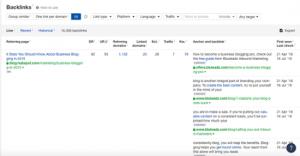
Brainstorming blog topics is not easy. I can state that confidently, after more than 6 years’ experience as a business blogger. Some businesses provide me with blog topics; some ask me to formulate them on their behalf. It can be difficult to come up with a constant stream of ideas, even if you do it for a living.
Sprouting blog topics is a good way to give your blog a cohesive theme, even if you don’t have time to develop a full content strategy with your SEO advisor, or freelance blogger. It’s also an efficient way to brainstorm for new content ideas, since you devise topics ‘in the moment’ as you write. (Not in a meeting, when you’re under pressure.)
I sprout topics in a hierarchical way. I write the core article, and then build satellites around it. I then launch blog posts in a carefully planned order, so that all the internal links are valid when they go live.
Why Sprout Blogs From One Idea?
There are three main reasons that I like to sprout topics like this:
- Sprouting blogs promotes internal linking organically. Internal links will reinforce your keywords, make navigation easier, and distribute link juice from a popular blog throughout your site. Here’s a very good blog from KissMetrics which explains the importance of internal linking.
- Formulating topics from existing content is very efficient. If you’re pushed for time, you’ll hesitate at the thought of writing a dozen blog posts for your business, rather than just one. But hear me out: if you sprout lots of sub-topics from one main topic, you get more mileage from one idea. The key is to invest time into ensuring every article is of a high quality, and to keep the topics closely related.
- Sprouting topic ideas is an effortless way to create more content. This is the best way to keep fresh content flowing, so you can show authority on a topic. Sustain your authority over a series, and give yourself more opportunities to build new themes with minimum effort.
Just one more thing. Have a notepad handy before you begin the first article. (I like to use Google Keep.)
1. Draft Out Your Evergreen Blog Content
Your brand new pillar post comes first. You (or your freelance blogger) is going to write this from your main topic idea.
You probably already have a pretty good framework in your head for this, so use that to your advantage. Invest lots of time and resource into getting it right. The pillar post is going to be the core of the series, and all the other articles will be satellites to it. (It’s also going to be the one you publish last, so don’t worry too much about fine-tuning just yet.)
As you write the pillar post, note down any requirement to link to another page for more information, or detail. These are going to be your ideas for satellite articles. You aren’t going to write all of these, but writing a good-sized list will give you more to work with later.
Don’t publish the core article yet.
2. Review the List of Satellite Topics
On your notepad (or virtual equivalent), review all the ideas that sprouted from your main article.
Select 1-2 ideas per 500 words of the original article, as a maximum. If you have too many, mark out the ones you feel most confident about. The other ideas can be turned into links to third party sites.
Discard any idea that isn’t a perfect fit for your niche.
3. Create Your Satellite Blog Content
Working from the list in step 2, write all of the satellite blogs that will surround your original piece. Remember:
- You may need a freelance blogger to offer some resource, and ensure variety. You want to avoid overlap and duplicate content.
- Plan to link satellites together, if the need arises. But don’t force any unnatural links into them.
- Pay attention to your keywords, and try to stick to similar themes.
- Note any more satellite topics that come up, and consider writing those up as well.
4. Create All Your Links
Now, you should have a clutch of blogs that all relate to each other, and a good idea of where the links are going to go. It’s time to plan the internal links that connect them.
Again, don’t do this unnaturally. Ensure the anchor text is loose, and only add these internal links where it makes sense to do so. Ideally, all internal links need to appear where they naturally came about when you wrote your pillar post. (If in doubt, less forced optimisation is always preferable.)
One of your satellites needs to link only to content already live on your site, for reasons that will become apparent in a moment.
5. Finalise and Schedule Your Blogs
This is the important part: you need to publish these blogs in the right order. You have a bunch of links going backwards and forwards, and it’s important that you don’t send any visitors to a missing page by publishing a ‘child’ before the ‘parent’. So, at this final step, you’re going to proofread your content, tweak it, and (potentially) tweak the links at the same time.
Set the blog with no new incoming links to publish first. Then, schedule any blogs with links to the first blog. Then you can schedule the next tier of blogs that link to the scheduled ones. And so on. You may need to tweak your linking strategy to make sure you’re always working backwards.
Normally, your initial pillar post will be one of the last to go live, since it has the most number of offshoot links.
Schedule your content to go live every few days, or once a week. This will build interest, and give Google fresh content to index over several weeks, without overloading people with too much at once.
Sprouting: Things to Remember
- Satellite articles should be as interesting, engaging and detailed as the main article. They don’t necessarily need to be the same length, but you should invest the same amount of effort so that the quality is consistent.
- Give all blogs a consistent style. If you’ve hired a freelance blogger to help you, ask them to tweak the content you wrote yourself so that it all has the same voice.
- Link out to other sites generously. Don’t hog the limelight. It pays to mix it up, so throw out a few links to authoritative sources, where they are naturally required.
- Optimise your anchor text, within reason. Long-tail phrases are fine; include a keyword now and again. Don’t link every occurrence of a phrase to another blog, and don’t try to over-organise your links; be as natural as you can without creating any broken ones.
- Avoid being too circular. Throw in an internal link to a static page, or to an older blog post, so that you distribute link juice throughout the whole site and avoid unnatural linking patterns.
- Don’t duplicate your ideas across blogs. Give each piece a unique reason to exist, and take it in its own direction.
- Check all of your links very carefully. The second the blog is published, go back and review it. Use IFTTT to up set an email alert, triggered by your RSS feed.
Other Ways to Use the Technique
Use the same sprouting technique to formulate topics for a book. Drill down into your chapter topics, and sprout new sections off existing ideas. You can also use this to spawn ideas for social media posts, or headings for new sections of your site.
Even if you choose not to sprout topics quite so methodically, sprouting is good practice for the future. Why? It makes you think from the reader’s point of view, which is sometimes difficult when you’re running a business. If a section of your content needs further explanation, jot it down as a future idea. Simple. Providing you stay on topic, stay natural, and hire quality freelance bloggers to support you, you’ll grow your blog organically and help to reinforce the themes of your site.
Digital & Social Articles on Business 2 Community(25)






